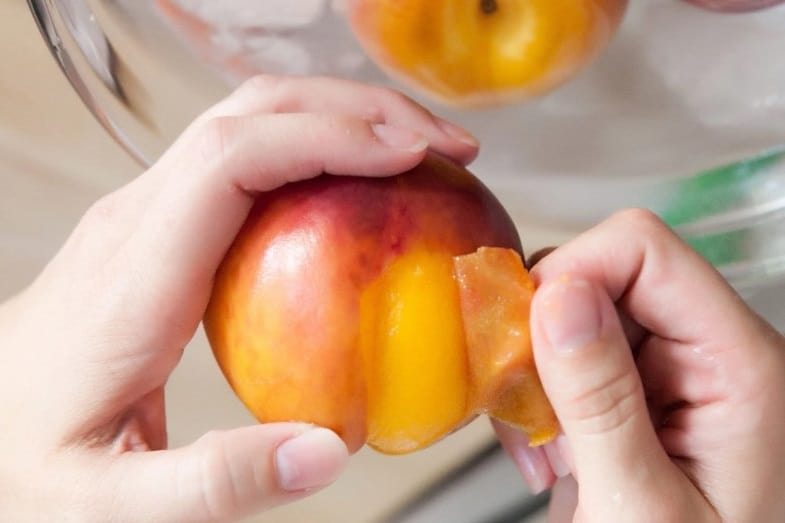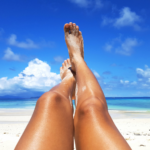Peaches are one of the most underrated fruits in the whole world. We all know the taste of an excellent in-season ripe peach fruit, but what most of us often overlook is its skin. A common question for many people is if it’s fine to eat peach skin, too.
Can you eat peach skin? Peach skin is entirely edible and has many health benefits, just like the fruit inside. It could be an acquired taste due to its fuzzy texture, but peach skin is quite nutritious. It is perfectly safe to eat peach skin, but you have to wash it properly to rid the skin of dirt, pesticides, and other chemicals unsafe for human consumption.
Proper preparation is not just applicable for peaches but to all other freshly picked produce as well. It’s better to be safe than sorry!
If you feel iffy about its skin, you can always discard it and eat the fruit instead–but don’t throw away the skin just yet! There are plenty of exciting recipes to try with peach skin peels. You’ll be able to help yourself be healthier while also helping the environment.
Read on to know more about peach skin, including its health benefits and possible risks. I’ll also list peach skin recipes that anyone will surely love.
Can You Eat Peach Skin? Health Benefits of Peach Skin
It seems frivolous to ask, but can you eat peach skin? Is it really safe to eat peach skin? You might be surprised just how many people wonder if you really can. After all, peaches are not the smoothest type of fruit. Unlike the common knowledge we have of other fruits and their skin like apples and bananas, peach skin tends to provide a sense of doubt–to eat or not to eat?
To solve this issue, we need to understand and appreciate the health benefits of peach skin first. Eating the fruit alone is already good for you, but think about the additional health benefits you can get if you also consume the skin.

1. Nutrient–dense Fruit
Experts have found that skins of fruits are so nutrient-packed that peeling and discarding the skins would be just a waste of proper nutrients. Antioxidant levels can be 328 times more in fruit skins than pulps and about 31% of vegetable fibers in its skin.
To put things in a better perspective, a raw apple with its skin, for example, has 332% more vitamin K, 115% more vitamin C, and 20% more calcium than a peeled apple. A potato boiled with the skin on contains up to 175% more vitamin C, 115% more potassium, and 110% more phosphorous and magnesium as compared to a peeled potato.
The same is true for peaches. Peach skin is full of antioxidants, vitamins, and fiber. Antioxidants, such as chlorogenic acid, assist in creating better immunity by preventing heart, eye, and even hormonal problems.
2. Rich in Antioxidants
Another reason why you certainly can eat peach skin and why it is beneficial to do so is the antioxidants. Antioxidants in peach skin also help solve skin problems by fighting oxygen-reacting compounds. Our pores require oxygen, and the antioxidants present in peach skin help fulfill this requirement.
The phenolic compounds and carotenoids present in peach skin are also potent antioxidants, making peach an anti-cancer fruit. These antioxidants are known to help minimize the risks of certain cancers, such as those affecting the lungs and breasts.
3. High Vitamin and Fiber Content
You should also eat peach skin because it has significant amounts of vitamins A and C. Vitamin A is especially helpful in keeping our eyes healthy and our bones strong. Peaches also have zeaxanthin and lutein, which are proven effective in reducing the chances of developing cataracts. Vitamin C, on the other hand, is best for keeping your cardiovascular (heart and blood vessel) system healthy. Both vitamins are also known to keep your skin healthy and glowing.
As for its high fiber content, it helps keep healthy bowel movements, along with assisting in blood sugar regulation and cholesterol levels. Fiber helps promote a healthy diet, whether you want to gain or lose some weight. Also, peach skin has anti-inflammatory properties that help keep the body functioning correctly.
Check out this link for the breakdown of nutrients in a serving of peach, as per the U.S. Department of Agriculture (USDA).
4. Helps in Skin Rejuvenation
Another reason why you can eat the skin of a peach and should eat it is because it is low in calories and without saturated fats. They are also cholesterol-free and sodium-free, making them a great addition to any diet. Peach skin alone also has properties that can help rejuvenate and beautify the skin. Here are some of its skin benefits:
- Helps in skin regeneration when used as a face wash (recipe below!)
- Helps get rid of blemishes and dark circles around the eyes
- Helps eliminate the early signs of wrinkles
- Aids in the repair of damaged tissues in minor wounds and scratches
5. Safe for Pregnant Women
Pregnant women can also safely include peaches in their diet as this fruit does not trigger any adverse reactions during this sensitive period–unless, of course, a pregnant woman is allergic to it. The nutrients present in peach, including its skin, can significantly help maintain the good health of the mother and her unborn child.
Risks of Eating Peach Skin
1. Peach Allergy
Similar to other fruits and vegetables, peaches can also cause allergic reactions to some people, and therefore, must be taken out of their regular diet. Allergies due to peaches are more attributed to the skin rather than the actual fruit itself.
A peach allergy can take on two different forms, which can be best understood when determining the areas where they are most common.
Northern Europe
Birch trees are abundant in northern European regions, and because of this, some people develop birch pollen allergies. The protein present in birch is very similar to the protein found in peaches, which is why people with a birch pollen allergy are also more prone to developing an allergy to peach skin.
This allergic reaction is called oral allergy syndrome (OAS). Its symptoms include itching around the mouth and throat within 5 to 15 minutes after the consumption of raw peaches.
Mediterranean Countries
Peach skin allergy in these countries does not originate from a birch-pollen allergy and presents more severe symptoms than those experienced in Northern Europe. In addition to OAS, symptoms like abdominal pain, vomiting, and hives may also be observed in this type of allergic reaction. Individuals with peach skin allergies may also experience symptoms more frequently and have even more adverse reactions.
According to the University of Manchester, both forms of peach skin allergy may also lead to adverse reactions to other foods, such as apples, apricots, cherries, hazelnuts, celeriac, and even carrots. The main difference is in the allergen that causes the reactions.
The allergen present in Mediterranean peaches is tougher and can survive in processed versions of foods, such as purees, juices, and nectars. The allergen in peaches from Northern Europe, on the other hand, does not survive when exposed to heat.
Such allergies to peach skin have been in the spotlight recently, thanks to the multi-awarded South Korean film Parasite. If you haven’t seen it yet, then I suggest you take the time, as it is a brilliant masterpiece, and the fruit, especially peach skin and its allergen, are featured in the film.
2. Presence of Pesticides on Peach Skin
With or without allergies, some people still prefer peeling off peach skin due to its fuzzy pollen-like texture. Aside from this, many people believe (and with good reason) that taking out the skin is an important step to get rid of harmful chemicals like pesticides, which may still be present on the fruit’s skin. But in doing so, you are missing out on all the beneficial things that peach skin provides.
A better way is to learn how to properly wash peaches for you to enjoy the entirety of the fruit while promoting zero waste management.
Continue reading below to know how to wash peach skin properly.
How to Wash Peach Skin
So can you eat peach skin? Yes, you certainly can eat peach skin safely, and in fact, there are many health benefits; however, it is important to wash the skin first. Washing peach skin is an easy task and takes no time at all. You just need a bowl, tap water, and a kitchen towel. Here are the simple steps:
- Remove any stems and leaves still attached to the peaches.
- Gently brush off any noticeable dirt on the peach skin using your hands.
- Place peaches in a big bowl, and run tap water until the peaches are covered. (Some even put a little liquid soap to wash away any chemicals on the surface.)
- Rub the surface of each fruit gently while submerged in water to remove more dirt and residues.
- Rinse each piece with running water and dry off gently with a soft kitchen towel.
Remember to be very gentle when washing peaches as the fruit is very soft and can bruise easily.
Peach Skin Recipes

Now that you have learned how to wash peach skin properly let me share some of its useful recipes. Peaches and their skin can be used not only in sweet summery jams and desserts but also as homemade skincare products, such as face masks. Here are some of the best peach skin recipes:
1. Peach Skin Sprinkles
You will need: Peach skin peels and sugar
Steps:
- Spread peach skins onto a baking sheet lined with parchment paper. Bake for 200°F (around 93°C) or until the peach skins are entirely dried out.
- Grind the dried peach skins using a coffee grinder, and then weigh it.
- After weighing ground peach skins, add an equal amount of sugar and grind the mixture again for a finer result.
You will end up with sweet and organic sprinkles that you can add to baked goods, drinks, and even main courses that call for a sweet element.
2. Peach Skin Syrup
You will need: Peach skin peels and pits, sugar, fine sieve or washcloth, and mason jars with lids.
Steps:
- Wash the mason jars and sterilize them in an oven on the lowest setting. Jar lids must be sterilized by boiling them in a pot of water. Once done, you can move on to preparing your recipe.
- Put peach skins and pits into a pot and add enough water to prevent it from burning. Bring to a boil on high, then turn the stove down to medium heat. Let it simmer for 45 minutes.
- Use a fine sieve or washcloth to strain the juice, being careful not to include any peach skin or pits. Do not squeeze any excess to keep your final product as clear as possible.
- Get a clean pot. Measure the juice before pouring it into the pot.
- Simmer the juice over medium heat. Put twice as much sugar and stir for 3 to 5 minutes or until the sugar completely dissolves.
- Transfer carefully to prepared jars and seal. Leave the jars on a countertop for 12 hours or until completely cooled.
The result will be a sweet peach syrup that’s perfect for pancakes, bread, and even tea!
3. Peach Skin Butter
You will need: 2 kg of peach skin, sugar, lemon juice, and water
Steps:
- Place 2 kg of peach skin into a pan and add an equal amount of sugar.
- Add lemon juice and ½ liter of water.
- Simmer and stir from time to time.
- Add more water each time it has evaporated, and make sure the skins do not stick to the bottom of the pan.
- Add more sugar to taste.
Peach skins need to disintegrate completely, and all sugars dissolved. The process takes about two days to complete to allow the mixture to thicken, similar to the consistency of butter. Once cooled, you may freeze it or process it in jars for storage in your pantry for a year! Find the complete recipe here.
4. Rejuvenating Peach Face Mask
It is safe, beneficial, and healthy to not only eat peach skin but also to use it as a rejuvenating skin face mask!
You will need: 1 tablespoon pureed peach and 2 teaspoons of plain yogurt
Steps:
- Mix pureed peach and plain yogurt in a small bowl until smoothly combined.
- Wash and exfoliate your face with a gentle scrub, then pat dry.
- Apply a thick layer of the peach mask on your face and leave it on for 20 minutes.
- Rinse off and apply moisturizer afterward.
The result will be clear, healthy, and glowing skin free from dead skin cells. Your skin will instantly feel more supple, hydrated, and smooth to the touch. You can get other DIY skincare products that use peaches here.
Conclusion – Can You Eat Peach Skin?
So now that you know what peaches are all about, let us go back to our original question – Can you eat peach skin?
Yes, you can eat peach skin. Peach skin is definitely edible and provides health benefits, that is, as long as it is appropriately washed to get rid of any harmful chemicals. Thorough washing of peaches may be a chore for some people, but surely it’s a step towards getting a good boost of nutrients in your diet.
Peach skin is also a great component of many delicious recipes. It also adds more color and life to your regular menu. You can also make natural and organic skincare products out of whole peach fruits to help keep your skin healthy without breaking the bank.
Just be wary of allergic reactions to peach skins, the same as you would do to any other fruit or vegetable you’re allergic to. Always remember that for any food you eat, you can better enjoy its benefits if you remind yourself of the risks.



![Neutral Skin Tone Defined [and Best Colors for Neutral Skin] neutral skin tone](https://skincaregeeks.com/wp-content/uploads/2021/05/neutral-skin-tone-150x150.png)





